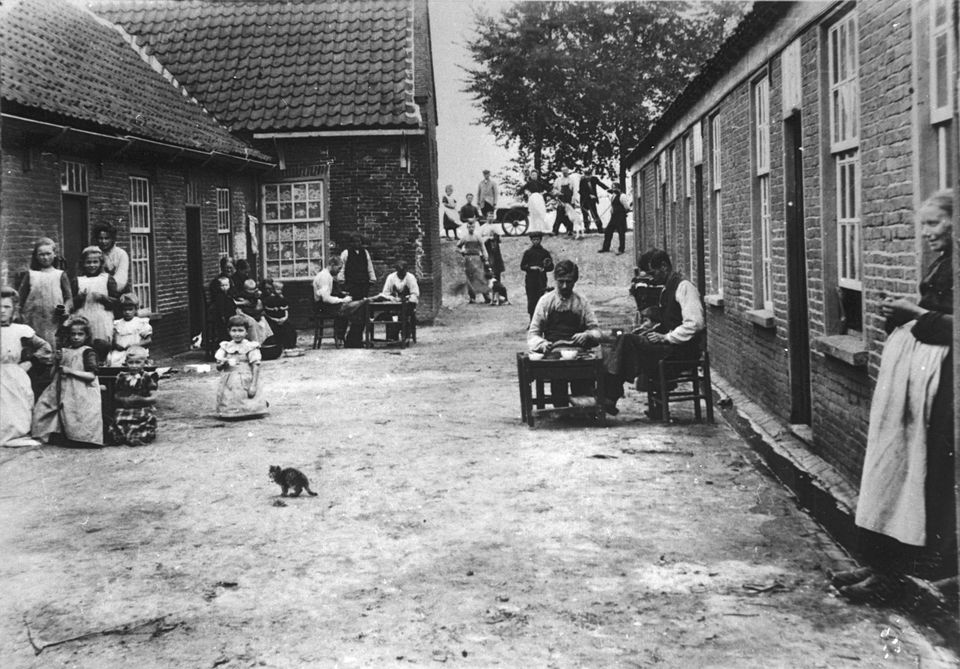Attention Stone - Gold Mine
Gold Mine (1862-1968) - Grotestraat 231
Heritage is that which you want to pass on to your children or the new generations. The working group 'Waalwijk: 100 years together' has selected a number of objects (heritage) in Baardwijk, Besoijen and Waalwijk center whose story we want to pass on to the next generation
the next generation. The bicycle and walking route 'On the road in the historical Langstraat' leads past these objects.
In 1862, bricklayer Adrianus van Rooij built 11 workers' houses in his garden; these houses were called "Gold Mine. Van Rooij had lived in Australia and had prospered there. This money he invested in workers' houses, the proceeds of the rent was called a gold mine'. This dam was the first to be called a 'mine'. A 'dam' is the connecting road from the public road to the
rear part of the...
Gold Mine (1862-1968) - Grotestraat 231
Heritage is that which you want to pass on to your children or the new generations. The working group 'Waalwijk: 100 years together' has selected a number of objects (heritage) in Baardwijk, Besoijen and Waalwijk center whose story we want to pass on to the next generation
the next generation. The bicycle and walking route 'On the road in the historical Langstraat' leads past these objects.
In 1862, bricklayer Adrianus van Rooij built 11 workers' houses in his garden; these houses were called "Gold Mine. Van Rooij had lived in Australia and had prospered there. This money he invested in workers' houses, the proceeds of the rent was called a gold mine'. This dam was the first to be called a 'mine'. A 'dam' is the connecting road from the public road to the
rear part of the plot. Since then, other rows of dam houses were also given the typical Waalwijk designation of 'mine'. In 1885, the east side of the dam was built on. A large number of home-working shoemakers lived in the 'Gold Mine'. The western part then consisted of nine houses built together with on the side of the Winterdijk two dike houses, built perpendicular to that row. Those last two cottages had their doors on the side of the Winterdijk. The men sitting at the low tables are shoemakers, who left their dark work store in nice weather to work outside.
World Chronicle
In the fall of 1905, a reporter and photographer visited the "Gold Mine. The report was published in 'The World Chronicle: illustrated newspaper for everyone,' of Oct. 7, 1905. 'We go into such a neighborhood where work chairs are outside. There they flick, choke and hammer and you see them rubbing their roefel-kai and bol-licker like crazy. Here are little houses braced together under a big roof, with narrow rooms, sparsely furnished, untidy here and clean there, bedsteads against the wall, the
the flowered cover, the floor sprinkled with white sand, a brightly polished or strongly rusted flat stove in the middle. You smell, though the wind howls freely down the alley, a peculiar air of leather and pitch and 'the burning of scraps (leather).'
Okke the Spider
A striking resident and local celebrity was shoemaker Okke "the spider" of Delft, who had a candy store there. His assortment
consisted of 'lucky charms', magic balls and licorice. An old townsman described his memories of Okke: 'The Marktstraatje, the Goudmijn and the Poststraat were the gateways to all that wide glory of the polders and at Okke's we bought magic balls for a penny.' Okke placed a New Year's message in the Echo of the South year after year. He was known as a joker first class. In 1935
he placed the following advertisement: 'OKKE hopes to take to the skies this year with his biplane and his orchestra and then play
he t is so nice to be in those 'drop fields'. Then we return to Holland again.' The west side was demolished in 1912, between 1965-1968 the east side and the three rear hovels were torn down for the construction of a telephone exchange.
